Appearance Colorless solid Formula C2H3Cl3O2 Molar mass 165.4 g/mol Density 1.91 g/cm³ | Related compounds CAS ID 302-17-0 Soluble in Water, Alcohol | |
 | ||
IUPAC ID 2,2,2-trichloroethane-1,1-diol | ||
Chloral hydrate is an organic compound with the formula C2H3Cl3O2. It is a colorless solid. It has limited use as a sedative and hypnotic pharmaceutical drug. It is also a useful laboratory chemical reagent and precursor. It is derived from chloral (trichloroacetaldehyde) by the addition of one equivalent of water.
Contents
- Chloral hydrate wmv
- Hypnotic
- Building block in organic synthesis
- Safety
- Production
- Pharmacodynamics
- Legal status
- Hoyers mounting medium
- Notable uses
- References
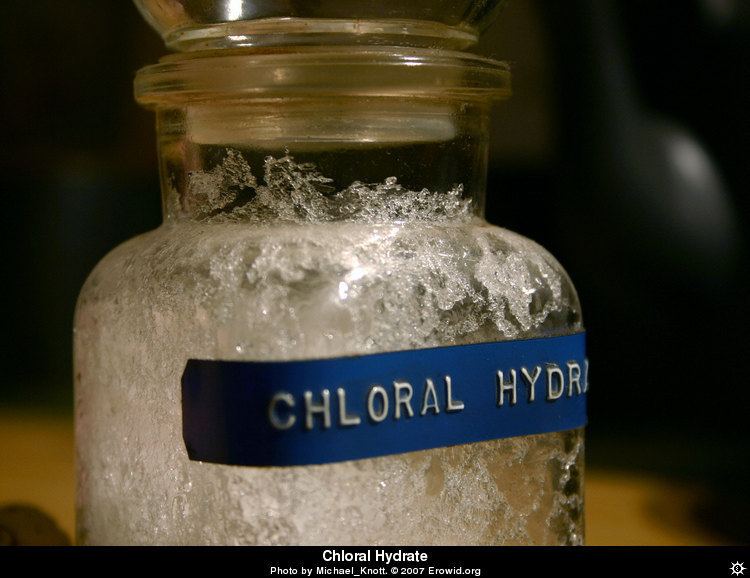
It was discovered through the chlorination (halogenation) of ethanol in 1832 by Justus von Liebig in Gießen. Its sedative properties were first published in 1869 and subsequently, because of its easy synthesis, its use was widespread. It was widely used recreationally and misprescribed in the late 19th century. Chloral hydrate is soluble in both water and ethanol, readily forming concentrated solutions. A solution of chloral hydrate in ethanol called "knockout drops" was used to prepare a Mickey Finn. More reputable uses of chloral hydrate include its use as a clearing agent for chitin and fibers and as a key ingredient in Hoyer's mounting medium, which is used to prepare permanent or semi-permanent microscope slides of small organisms, histological sections, and chromosome squashes. Because of its status as a regulated substance, chloral hydrate can be difficult to obtain. This has led to chloral hydrate being replaced by alternative reagents in microscopy procedures.
It is, together with chloroform, a minor side-product of the chlorination of water when organic residues such as humic acids are present. It has been detected in drinking water at concentrations of up to 100 micrograms per litre (µg/L) but concentrations are normally found to be below 10 µg/L. Levels are generally found to be higher in surface water than in ground water.
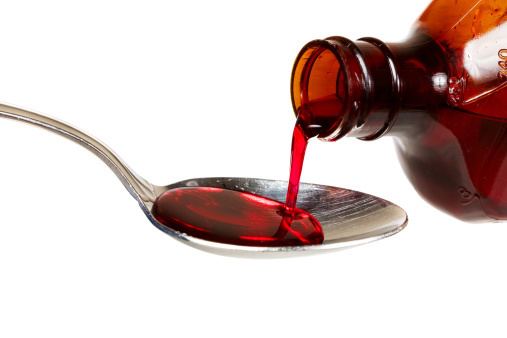
Chloral hydrate has not been approved by the FDA in the United States or the EMA in the European Union for any medical indication and is on the list of unapproved drugs that are still prescribed by clinicians. Usage of the drug as a sedative or hypnotic may carry some risk given the lack of clinical trials.
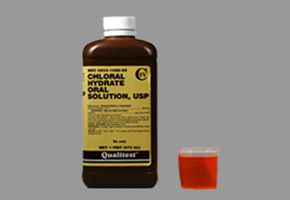
Chloral hydrate wmv
Hypnotic
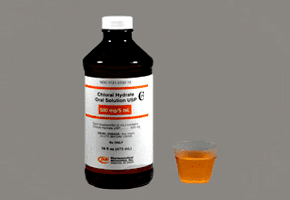
Chloral hydrate is used for the short-term treatment of insomnia and as a sedative before minor medical or dental treatment. It was largely displaced in the mid-20th century by barbiturates and subsequently by benzodiazepines. It was also formerly used in veterinary medicine as a general anesthetic. It is also still used as a sedative prior to EEG procedures, as it is one of the few available sedatives that does not suppress epileptiform discharges.
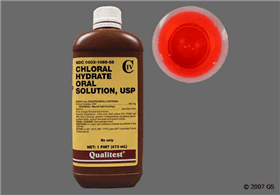
In therapeutic doses for insomnia, chloral hydrate is effective within 20 to 60 minutes. In humans it is metabolized within 7 hours into trichloroethanol and trichloroethanol glucuronide by erythrocytes and plasma esterases and into trichloroacetic acid in 4 to 5 days. It has a very narrow therapeutic window making this drug difficult to use. Higher doses can depress respiration and blood pressure.
Building block in organic synthesis
Chloral hydrate is a starting point for the synthesis of other organic compounds. It is the starting material for the production of chloral, which is produced by the distillation of a mixture of chloral hydrate and sulfuric acid, which serves as the desiccant.
Notably, it is used to synthesize isatin. In this synthesis, chloral hydrate reacts with aniline and hydroxylamine to give a condensation product which cyclicizes in sulfuric acid to give the target compound:
Safety
Chloral hydrate was routinely administered to people on the gram scale. Prolonged exposure to the vapors is unhealthy however, with a LD50 for 4-hour exposure of 440 mg/m3. Long-term use of chloral hydrate is associated with a rapid development of tolerance to its effects and possible addiction as well as adverse effects including rashes, gastric discomfort and severe kidney, heart, and liver failure.
Acute overdosage is often characterized by nausea, vomiting, confusion, convulsions, slow and irregular breathing, cardiac arrhythmia, and coma. The plasma, serum or blood concentrations of chloral hydrate and/or trichloroethanol, its major active metabolite, may be measured to confirm a diagnosis of poisoning in hospitalized patients or to aid in the medicolegal investigation of fatalities. Accidental overdosage of young children undergoing simple dental or surgical procedures has occurred. Hemodialysis has been used successfully to accelerate clearance of the drug in poisoning victims.
Production
Chloral hydrate is produced from chlorine and ethanol in acidic solution. In basic conditions the haloform reaction takes place and chloral hydrate is decomposed by hydrolysis to form chloroform.
4 Cl2 + C2H5OH + H2O → Cl3CCH(OH)2 + 5 HClPharmacodynamics
Chloral hydrate is metabolized in vivo to trichloroethanol, which is responsible for its physiological and psychological effects.
The metabolite of chloral hydrate exerts its pharmacological properties via enhancing the GABA receptor complex and therefore is similar in action to benzodiazepines, nonbenzodiazepines and barbiturates. It can be moderately addictive, as chronic use is known to cause dependency and withdrawal symptoms. The chemical can potentiate various anticoagulants and is weakly mutagenic in vitro and in vivo.
Legal status
Chloral hydrate is illegal without a prescription and is a schedule IV controlled substance in the United States. Its properties have sometimes led to its use as a date rape drug. Chloral hydrate is still available in the United States, though it is relatively uncommon and not often kept in the inventory of major pharmacies. It has largely been abandoned for the treatment of insomnia in favor of newer drugs such as the Z-drugs family, which includes zolpidem, zaleplon, zopiclone and eszopiclone. A small number of medical practitioners continue to prescribe it to treat insomnia when all other more modern medications have failed. In the United States, it is commonly supplied in syrup form in a 500 mg/5mL concentration. It is also supplied in suppository form, though the use of this method of administration is extremely rare.
It is not controlled in Canada except that a prescription is required to purchase the pharmaceutical forms. Possession without a prescription is not illegal and industrial trade is not regulated.
The United Kingdom does not consider chloral hydrate to be a controlled substance.
Chloral hydrate is a prescription-only-medicine (POM) in the Netherlands, but possession without a valid prescription will result only in the seizure of the drug, not prosecution. Production, sale and distribution are however punishable by law. It is not listed under the Dutch Opium Law, but when the intent is human consumption, it is covered by the Geneesmiddelenwet (Medicine Act).
Hoyer's mounting medium
Chloral hydrate is also an ingredient used for Hoyer's solution, a mounting medium for microscopic observation of diverse organisms such as bryophytes, ferns, seeds, and small arthropods (especially mites). One recipe for making Hoyer's is dissolving gum arabic (30 g) in water (50 mL), then adding chloral hydrate (200 g), and then finally adding glycerol (16 mL). An advantage of this medium include a high refraction index and clearing (macerating) properties of the small specimens (especially advantageous if specimens require observation with differential interference contrast microscopy). The major disadvantage of Hoyer's is its susceptibility to the effects of rehydration, which causes the mountant to crystallize and threatening the slide to become unusable. It is therefore absolutely necessary, after drying a mounted specimen, to thoroughly ring (2 layers are best) cover slips with a protective coating (e.g., insulating glyptol), which prevents rehydration and mountant deterioration. Chloral hydrate reportedly does not effectively clear larger specimens, or arthropods that are more heavily sclerotized (e.g., larger insects). These should first be cleared with another product (e.g., 10% KOH or NaOH), and then mounted in Hoyer's. Other disadvantages of Hoyer's (principally due to chloral hydrate) include toxicity (see above), and procurement problems due to chloral hydrate being a controlled substance.
